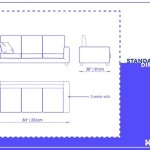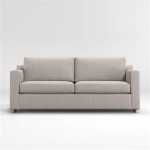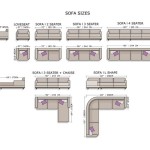Standard Sofa Arm Height: A Comprehensive Guide
Sofa arm height, often overlooked, is a critical element in both the aesthetic and functional design of a sofa. The height of the sofa arms significantly impacts comfort, posture, and the overall usability of the seating arrangement. While designs vary widely, understanding the standard arm height and factors influencing it is essential for selecting a sofa that meets specific needs and preferences. This article will explore the typical range of sofa arm heights, the reasons behind these standards, and the considerations that should inform the choice of arm height for optimal comfort and style.
The term "standard sofa arm height" generally refers to the average height range found in commercially available sofas. However, this is not a rigid, universally mandated measurement. Instead, it represents a common range that has evolved based on ergonomic considerations, stylistic trends, and the desire to create a balanced and comfortable seating experience. This article delves into the range of sofa arm heights.
Determining the ideal sofa arm height is not solely about conforming to a standard. It is also about understanding individual needs, the intended use of the sofa, and the desired aesthetic. Considerations like the height of the users, the preferred seating posture, and the style of the room all play a role in selecting the most appropriate arm height. A sofa with arms that are too low may provide insufficient support, while arms that are too high might feel restrictive and uncomfortable.
Before delving into the specific heights and variations, it's important to define what constitutes the "arm" of a sofa. In this context, the arm refers to the upholstered or otherwise finished portion of the sofa that extends upward from the seat cushion, providing lateral support and a resting place for arms. This excludes any purely decorative elements that may extend beyond the functional arm surface. The height is typically measured from the floor to the highest point of the arm, considering any cushioning or upholstery.
Typical Range of Sofa Arm Heights
The most commonly encountered range for sofa arm heights falls between 24 and 32 inches. This encompasses a broad spectrum of styles, from more traditional designs to contemporary models. Sofas within this range tend to offer a balance between support and accessibility, making them suitable for a variety of users and purposes.
Arm heights at the lower end of this spectrum, around 24 to 26 inches, are often found in sofas with a more modern or minimalist aesthetic. These lower arms can create a sense of openness and visual lightness in a room. They may also be preferred by individuals who prefer a more relaxed or reclined seating posture, as they allow for easier arm movement and less restriction.
Conversely, sofas with arm heights towards the higher end, around 30 to 32 inches, tend to offer more substantial support. These taller arms are often found in traditional or transitional sofa styles. They can provide a more structured and upright seating experience, which may be preferred by individuals who require more support or who frequently use the arms for leaning and stability.
It's crucial to understand that the specific measurements can vary between manufacturers and even within individual product lines. Therefore, relying on general guidelines alone is insufficient. Always consult the product specifications or, ideally, physically test the sofa to ensure the arm height is appropriate for your needs.
Outside of the typical range, there are sofas with arm heights that deviate significantly. Some sofas feature arm heights below 24 inches, often referred to as "low-profile" designs. These are usually found in modern or European-inspired styles and prioritize a sleek, streamlined appearance. On the other hand, some sofas might have arm heights exceeding 32 inches, offering exceptionally high support. These are less common but can be found in certain traditional or custom-made pieces.
Factors Influencing Sofa Arm Height Choices
Several factors play a role in determining the most suitable sofa arm height. These include ergonomic considerations, stylistic preferences, the intended use of the sofa, and the physical characteristics of the individuals who will be using it. Each of these aspects contributes to the overall comfort and functionality of the sofa.
Ergonomics is paramount when selecting a sofa. An ergonomically designed sofa should support the natural curvature of the spine and allow for a comfortable and sustainable seating posture. The arm height should contribute to this by providing adequate support for the arms and shoulders. Arms that are too low can lead to slouching and strain on the neck and back, while arms that are too high can cause shoulder impingement and discomfort. The ideal height is one that allows the arms to rest comfortably without requiring the user to hunch or reach awkwardly.
Stylistic preferences also play a significant role. The arm height contributes to the overall aesthetic of the sofa, influencing its perceived level of formality, modernity, or traditionalism. Low-profile arms tend to create a more contemporary and minimalist look, while taller, more ornate arms often project a sense of classic elegance. The choice of arm height should align with the overall design scheme of the room and the desired visual impact.
The intended use of the sofa is another important consideration. A sofa that is primarily used for lounging and relaxation may benefit from lower arms, as they allow for greater flexibility in positioning and movement. Conversely, a sofa intended for more formal seating or conversation may benefit from higher arms, as they provide more support and encourage an upright posture. Consider how the sofa will be used most often when making a decision about arm height.
Finally, the physical characteristics of the individuals who will be using the sofa should be taken into account. Taller individuals may require higher arms for adequate support, while shorter individuals may find lower arms more comfortable. The arm height should be proportionate to the user's height and build to ensure a comfortable and ergonomic seating experience. If the sofa will be used by individuals with significantly different heights, it may be necessary to compromise and select an arm height that is comfortable for the majority of users.
Considering Furniture Placement and Space
The surrounding furniture and the overall dimensions of the room should also influence the choice of sofa arm height. A room with low ceilings might benefit from a sofa with lower arms to create a sense of spaciousness, while a larger room can accommodate a sofa with taller arms without feeling cramped. The height of the sofa arms should also be considered in relation to other furniture pieces in the room, such as coffee tables and side tables. The goal is to create a cohesive and balanced arrangement where the various elements complement each other.
When selecting a sofa, it is essential to consider the overall proportions of the piece, including the arm height, seat depth, and back height. These dimensions should work together harmoniously to create a comfortable and aesthetically pleasing seating experience. A sofa with very high arms and a shallow seat depth, for example, might feel disproportionate and uncomfortable. It is important to assess the sofa as a whole, rather than focusing solely on the arm height. Thinking about the placement of cushions and other elements that can affect the height is also important.
Ultimately, the choice of sofa arm height is a personal one that should be based on individual needs, preferences, and the specific characteristics of the space. While the standard range provides a useful starting point, it is important to consider all of the factors discussed above to ensure that the selected sofa offers optimal comfort, support, and aesthetic appeal.
Before making a final decision, it is always advisable to try out the sofa in person, if possible. Physically sitting on the sofa and assessing the arm height can provide valuable insights that cannot be gleaned from simply looking at measurements. Pay attention to how the arms support your arms and shoulders, how comfortable you feel in the seated position, and whether the arm height feels proportionate to your body. This hands-on evaluation can help you make a more informed and confident choice.
In summary, the standard sofa arm height, typically ranging from 24 to 32 inches, serves as a general guideline. However, selecting the appropriate arm height involves considering ergonomic factors, stylistic preferences, intended use, and individual physical characteristics. Careful consideration of these aspects, along with the surrounding furniture and room dimensions, ensures a comfortable and aesthetically pleasing seating arrangement.

Six Common Mistakes When A Sofa And Ways To Avoid Them

Low Sofa Arm Or High The Stated Home Blog

The Taylor Custom Petite Roll Arm Sofas Sectionals More Of Iron Oak

Sofa Dimensions 101 Measuring For Your Perfect
Your Guide To Measuring For Sofa

Standard Sofa Dimensions For 2 3 4 And 5 Person Charts Diagrams Engineering Discoveries

Sofa Dimensions For 2 3 4 5 6 Person Couches Diagrams Included Home Stratosphere

End Table Heights

Sofa Dimensions For 2 3 4 And 5 Person Couches Charts Diagrams Formal Living Room Designs Design

Emerson 104 Inch Sofa Of Iron Oak
Related Posts








